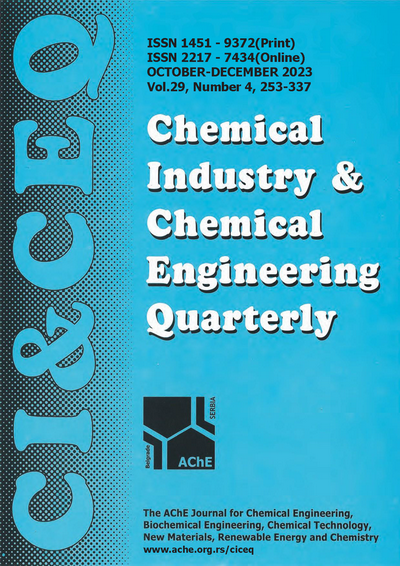PROCESS STUDY OF CeO2 PREPARATION BY JET-FLOW PYROLYSIS VIA MICROWAVE HEATING
Original scientific paper
DOI:
https://doi.org/10.2298/CICEQ220510034CKeywords:
cerium oxide, economic benefit, microwave heating, numerical simulationAbstract
The spray pyrolysis method has the disadvantage of nozzle plugging, and the conventional heating model causes a large temperature gradient, which leads to unevenly heated reactants. This study used cerium chloride heptahydrate and Venturi reactor as raw material and core equipment. The technology of microwave heating was combined to prepare single-phase sphere-like cerium oxide. The mean size of the particles was near 80nm. The product was characterized via XRD, SEM, and EDS technologies. The purity, morphology, and energy consumption were compared with the conventional spray pyrolysis. Fluent software coupled with HFSS was employed to simulate the effects of different process conditions on products’ purity and temperature field in the reactor. There was good correspondence between experimental and simulated results. The results showed that as gas velocity Vg increased, the tendency of the temperature field distribution did not change. The lowest mass fraction of chlorine element reached 0.13% when the gas inlet velocity reached 1.7 m/s. When the material inlet velocity was 0.05 m/s, the mass fraction of the chlorine element was below 0.1%, which indicated that the reactants had a complete reaction. It has been calculated that the heating cost, energy consumption, and CO2 emission decreased sharply compared with the spray pyrolysis method.
References
K.B. Kusuma, M. Manju, C.R. Ravikumar, N. Raghavendra, M.A. Shilpa Amulya, H.P. Nagaswarupa, H.C. Ananda Murthy, M.R. Anil Kumar, T.R. Shashi Shekhar, Appl. Surf. Sci. Adv. 11 (2022) 100304. https://doi.org/10.1016/j.apsadv.2022.100304.
P. Janos, J. Ederer, V. Pilarova, J. Henych, J. Tolasz, D. Milde, T. Opletal, Wear 362-363 (2016) 114—120. https://doi.org/10.1016/j.wear.2016.05.020.
S.J. Liang, X. Jiao, X.H. Tan, J.Q. Zhu, Appl. Opt. 57 (2018) 5657—5665. https://doi.org/10.1364/AO.57.005657.
F. Wei, C.J. Neal, T.S. Sakthivel, Y.F. Yu, M. Omer, A. Adhikary, S. Ward, K.M. Ta, Bioact. Mater. 21 (2023) 547—565. https://doi.org/10.1016/j.bioactmat.2022.09.011.
M. Ramachandran, M. Shanthi, R. Subadevi, M. Sivakumar, Vacuum 161 (2019) 220—224. https://doi.org/10.1016/j.vacuum.2018.12.002.
S. Gnanam, V. Rajendran, J. Alloys Compd. 735 (2018) 1854—1862. https://doi.org/10.1016/j.jallcom.2017.11.330.
C. Lv, Q.Y. Zhao, Z.M. Zhang, Z.H. Dou, T.A. Zhang, H.L. Zhao, Trans. Nonferrous Met. Soc. China 25 (2015) 997—1003. https://doi.org/10.1016/S1003-6326(15)63690-1.
A.Z. Fia, J. Amorim, Energy 218 (2021) 119472. https://doi.org/10.1016/j.energy.2020.119472.
J. Liu, J.H. Liu, B.W. Wu, S.B. Shen, G.H. Yuan, L.Z. Peng, Chin. J. Eng. 39 (2017) 208—214. DOI: 10.13374/j.issn2095-9389.2017.02.007.
E. Meloni, M. Martino, M. Pierro, P. Pullumbi, F. Brandani, V. Palma, Energies 15 (2022) 4119. https://doi.org/10.3390/en15114119.
V. Palam, D. Barba, M. Cortese, M. Martino, S. Renda, E. Meloni, Catalysts 10 (2020) 246. https://doi.org/10.3390/catal10020246.
E. Meloni, M. Martino, V. Palma, Renewable Energy 197 (2022) 893—931. https://doi.org/10.1016/j.renene.2022.07.157.
J.Y. Zhu, L.P. Yi, Z.Z. Yang, M. Duan, Chem. Eng. J. 407 (2021) 127197. https://doi.org/10.1016/j.cej.2020.127197.
D. Salvi, D. Boldor, G.M. Aita, C.M. Sabliov, J. Food Eng. 104 (2011) 422429. https://doi.org/10.1016/j.jfoodeng.2011.01.005.
C.D. Si, J.J. Wu, Y.X. Zhang, G.J. Liu, Q.J. Guo, Fuel 242 (2019) 159—149. https://doi.org/10.1016/j.fuel.2019.01.002.
D.L. Ye. Practical Inorganic Thermodynamics Data Manual; Cao, S.L., Ed., Metallurgical Industry Press, Beijing (1981), p. 262—263, 265–266. ISBN:7-5024-3055-5.
X.H. Liu. (2011). [Master's Thesis, Northeastern University]. China National Knowledge Infrastructure. https://kns.cnki.net/kcms2/article/abstract?v=3uoqIhG8C475KOm_zrgu4lQARvep2SAkbl4wwVeJ9RmnJRGnwiiNVgbPSHgq3mML_3baomtbo8MY72vRZI789SFqng4qPhOf&uniplatform=NZKPT.
Downloads
Published
Issue
Section
License
Copyright (c) 2021 Lv Chao, Yin Hongxin, Liu Yanlong, Chen Xuxin, Sun Minghe, Zhao Hongliang

This work is licensed under a Creative Commons Attribution-NonCommercial-NoDerivatives 4.0 International License.
Authors who publish with this journal agree to the following terms:
Authors retain copyright and grant the journal right of first publication with the work simultaneously licensed under a Creative Commons Attribution License that allows others to share the work with an acknowledgement of the work's authorship and initial publication in this journal.
Authors grant to the Publisher the following rights to the manuscript, including any supplemental material, and any parts, extracts or elements thereof:
- the right to reproduce and distribute the Manuscript in printed form, including print-on-demand;
- the right to produce prepublications, reprints, and special editions of the Manuscript;
- the right to translate the Manuscript into other languages;
- the right to reproduce the Manuscript using photomechanical or similar means including, but not limited to photocopy, and the right to distribute these reproductions;
- the right to reproduce and distribute the Manuscript electronically or optically on any and all data carriers or storage media – especially in machine readable/digitalized form on data carriers such as hard drive, CD-Rom, DVD, Blu-ray Disc (BD), Mini-Disk, data tape – and the right to reproduce and distribute the Article via these data carriers;
- the right to store the Manuscript in databases, including online databases, and the right of transmission of the Manuscript in all technical systems and modes;
- the right to make the Manuscript available to the public or to closed user groups on individual demand, for use on monitors or other readers (including e-books), and in printable form for the user, either via the internet, other online services, or via internal or external networks.
How to Cite
Funding data
-
National Natural Science Foundation of China
Grant numbers 51904069 -
Fundamental Research Funds for the Central Universities
Grant numbers N2223026 -
Northeastern University
Grant numbers XNY201808






